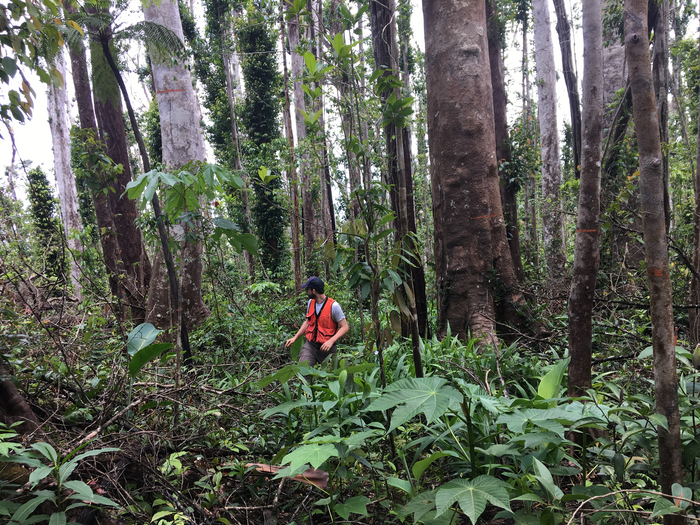
A recent study conducted in Dominica revealed that despite the widespread damage caused by Hurricane Maria, an astonishing 89% of the trees studied survived, with only a mere 10% experiencing immediate mortality. These remarkable findings were published in the March 2023 issue of the journal Forest Ecology and Management.
During their descent to land at the airport on Dominica, researchers from Clemson and Harvard universities peered out of the airplane window and were met with a disheartening sight. The vast stretches of forests below resembled mere matchsticks, with trees reduced to a fraction of their former size.
Nine months had passed since the West Indies island endured the devastating impact of Category 5 Hurricane Maria. However, when the researchers ventured into the forests and conducted a closer examination of the trees, they made an astonishing discovery. Despite 89% of the trees experiencing some level of damage, with a significant 76% sustaining major damage, only a mere 10% had succumbed immediately. Many of the resilient trees had begun to resprout, displaying their incredible ability to recover and persevere.
Benton Taylor, an assistant professor in the Harvard University Department of Organismic and Evolutionary Biology and former graduate student at Clemson Department of Biological Sciences, highlighted the remarkable resilience of hurricane-prone forests. He emphasized that despite the immense damage inflicted upon these forests, it is crucial to acknowledge the impressive level of resistance demonstrated by the surviving trees. Taylor stated:
“The fact that 90% of the trees endured speaks volumes about their incredible ability to withstand even the most powerful hurricanes.”
The rise in climate change has led to an escalation in both the frequency and intensity of hurricanes. Numerous areas across the globe that frequently encounter hurricane disturbances hold significant significance in the cycles of carbon, water, and nutrients. These regions, known as global “hotspots” of biodiversity, play crucial roles in maintaining the delicate balance of ecosystems.
On September 18, 2017, Dominica experienced the devastating impact of Hurricane Maria, which brought winds exceeding 160 mph. This historic hurricane became the strongest ever recorded to make landfall on the island. In the days that followed, Maria unleashed its destructive force upon the U.S. territory of Puerto Rico, causing widespread devastation.
Supported by the Clemson Caribbean Initiative, a team consisting of Department of Biological Sciences Chair Saara DeWalt, Benton Taylor, and Dominican researcher Elvis Stedman undertook the task of remeasuring and evaluating the extent of damage to trees in nine forest stands throughout Dominica. These plots were initially established in 2006 by DeWalt and former Clemson researcher Kalan Ickes. In addition to tree measurements, the team also assessed wood density and carbon content for the 44 most prevalent tree species. By combining these data, they estimated biomass and determined the amount of carbon that had been displaced from living to dead trees as a result of the hurricane’s impact.
The research findings revealed that among the various types of damage observed, stem snapping was the most common, affecting 40% of the trees, followed by major branch damage, affecting 26% of the trees. However, the damage types associated with the highest mortality rates were uprooting and being crushed by neighboring trees. Among the uprooted trees, 33% did not survive, while a staggering 47% of the trees that were crushed met a similar fate.
DeWalt, a senior researcher involved in the study, pointed out that snapping, contrary to expectations, did not result in as much mortality as one might assume. The study indicated that larger individual trees and species with lower wood density were more vulnerable to snapping, uprooting, and subsequent mortality. Additionally, trees located on steeper slopes were found to be at a higher risk of being crushed by neighboring trees.
DeWalt emphasized that the increasing frequency of storms in hurricane-prone regions will have a significant impact on the structure and composition of forests. She anticipates a transition towards smaller tree species with high wood density. As she explains:
“Forests have adapted to endure such disturbances, but as we witness a rise in the frequency of powerful hurricanes, we may observe a shift in the prevalence of certain species within these forests. Species that exhibit a ‘live fast, die young’ characteristic may become more dominant as the forest undergoes constant resetting.”
According to Taylor, the potential decline in the number of large, old trees could have implications for wildlife. Specifically, two parrot species unique to Dominica, namely the Sisserou and Jaco parrots, depend on cavities found in large trees for nesting purposes. These parrots are exclusive to the island nation, highlighting the importance of preserving the habitats of these iconic bird species.
According to Taylor, larger trees exhibited a higher susceptibility to damage and mortality. These substantial trees play a crucial role in carbon storage, and in Dominica, they serve as essential habitats for various animals, including the parrots. Understanding how different tree species and sizes are affected by hurricanes through the collected data enables us to make predictions about the future of these forests and the invaluable services they offer.
While comprehending how forests respond to hurricanes in general is beneficial for understanding the impact in hurricane-prone regions of the southern United States, Taylor emphasizes the importance of exercising caution.
“In a field where opportunities to study rare phenomena like hurricanes are limited, any additional data we can gather is valuable,” Taylor explained.
“However, our study underscores the importance of recognizing that the effects of hurricanes can vary significantly depending on local topography and the specific tree species within a forest. Therefore, it is crucial to exercise caution when comparing the findings from a small, mountainous island populated by tropical rainforest trees to the forests found in the coastal plains and piedmont regions of the southern United States.”

